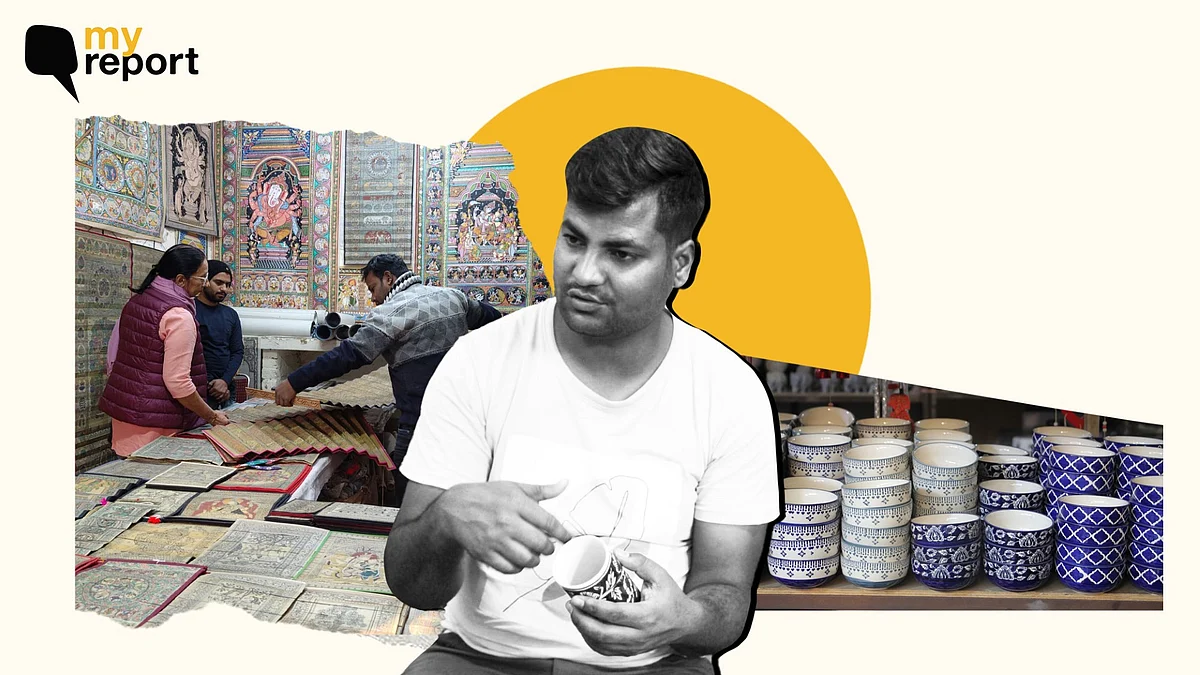
'Dilli Haat Artisans Eager to Keep Art Alive, But Wonder at What Cost'
'At Dilli Haat, artisans have stories to tell – stories of hope and passion, but also of their struggles.'

advertisement
At Dilli Haat, right in the heart of south Delhi, artisans have stories to tell – stories of hope and passion, but also of their struggles.
A popular tourist destination, the permanent open-air market even attracts locals who come to purchase handicrafts or paintings or simply unwind.
Inaugurated in March 1994 and spread over six acres of reclaimed land, the market was envisaged as a platform for artisans and craftsmen from across the country to showcase their work.
Then why are they struggling?
Sharing her ordeal, Kamini Sinha, a Madhubani and Sohrai artist from Jharkhand, says:
Kamini Sinha, a Madhubani and Sohrai artist from Jharkhand.
(Photo Credit: Shambhavi Srivastava)
"I have around 25 women working with me – and I want more people to recognise our work. But since my sales are affected, it has become difficult for me to pay my staff," adds Sinha.
Despite being an original artisan, Sinha has never been able to get a shop in the main row of the haat, potentially affecting her sales.
Khurja, a traditional Indian pottery style from Bulandshahr in Uttar Pradesh, has been facing similar competition, negatively impacting artisans.
Irfan, a Khurja artist, at his stall in Dilli Haat.
(Photo Credit: Shambhavi Srivastava)
Handmade Khurja art on utensils at Irfan's stall in Dilli Haat.
(Photo Credit: Shambhavi Srivastava)
'Hard to Stay Relevant'
Many of the artworks on display at Dilli Haat are protected by a geographical indication (GI) tag, a sign used for products to specify their origin. But, despite this, artisans struggle to maintain their relevance in the modern world. Nevertheless, the primary aim of artisans travelling to Dilli Haat from their home states is to popularise their art or craft.
Ravindra Behra, a Pattachitra artist from Odisha, at his stall in Dilli Haat.
(Photo Credit: Shambhavi Srivastava)
Sitting in his shop surrounded by his intricate paintings, Ravindra Behra, a Pattachitra artist from Odisha, tells me his reasons for coming to Dilli Haat.
Suresh Kumar Dhrube, a Gond artist.
(Photo Credit: Shambhavi Srivastava)
New forms of deceit have cropped up with people clicking photographs of the works they see at places like Dilli-Haat and creating duplicates to earn profits. However, this does not deter Suresh Kumar Dhrube, a Gond artist, from coming to the haat.
While this culture of making easy money through selling duplicates does sadden him a bit, he is confident that no one can copy his creativity and imagination, and he believes his efforts will pay off one day.
(All 'My Report' branded stories are submitted by citizen journalists to The Quint. Though The Quint enquires into the claims/allegations from all parties before publishing, the report and the views expressed above are the citizen journalist's own. The Quint neither endorses, nor is responsible for the same.)
- Access to all paywalled content on site
- Ad-free experience across The Quint
- Early previews of our Special Projects
Published: undefined